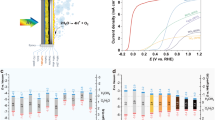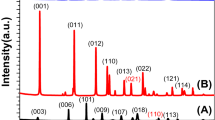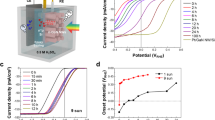Abstract
For practical photoelectrochemical water splitting to become a reality, highly efficient, stable and scalable photoelectrodes are essential. However, meeting these requirements simultaneously is a difficult task, as improvements in one area can often lead to deteriotation in others. Here, addressing this challenge, we report a formamidinium lead triiodide (FAPbI3) perovskite-based photoanode that is encapsulated by an Ni foil/NiFeOOH electrocatalyst, which demonstrates promising efficiency, stability and scalability. This metal-encapsulated FAPbI3 photoanode records a photocurrent density of 22.8 mA cm−2 at 1.23 VRHE (where VRHE is voltage with respect to the reversible hydrogen electrode) and shows excellent stability for 3 days under simulated 1-sun illumination. We also construct an all-perovskite-based unassisted photoelectrochemical water splitting system by connecting the photoanode with a same-size FAPbI3 solar cell in parallel, which records a solar-to-hydrogen efficiency of 9.8%. Finally, we demonstrate the scale-up of these Ni-encapsulated FAPbI3 photoanodes into mini-modules up to 123 cm2 in size, recording a solar-to-hydrogen efficiency of 8.5%.
This is a preview of subscription content, access via your institution
Access options
Access Nature and 54 other Nature Portfolio journals
Get Nature+, our best-value online-access subscription
$29.99 / 30 days
cancel any time
Subscribe to this journal
Receive 12 digital issues and online access to articles
$119.00 per year
only $9.92 per issue
Buy this article
- Purchase on Springer Link
- Instant access to full article PDF
Prices may be subject to local taxes which are calculated during checkout





Similar content being viewed by others
Data availability
All data generated or analysed during this study are included in the published article. The experimental data for all the supplementary figures are provided as Supplementary Data. Source data are provided with this paper.
References
Fujishima, A. & Honda, K. Electrochemical photolysis of water at a semiconductor electrode. Nature 238, 37–38 (1972).
Kim, J. H., Hansora, D., Sharma, P., Jang, J. W. & Lee, J. S. Toward practical solar hydrogen production – an artificial photosynthetic leaf-to-farm challenge. Chem. Soc. Rev. 48, 1908–1971 (2019).
He, Y. & Wang, D. Toward practical solar hydrogen production. Chem 4, 405–408 (2018).
Ye, K. H. et al. Enhancing photoelectrochemical water splitting by combining work function tuning and heterojunction engineering. Nat. Commun. 10, 3687 (2019).
Kim, J. H. et al. Hetero-type dual photoanodes for unbiased solar water splitting with extended light harvesting. Nat. Commun. 7, 13380 (2016).
Yang, Y. et al. Progress in developing metal oxide nanomaterials for photoelectrochemical water splitting. Adv. Energy Mater. 7, 1700555 (2017).
Jiang, C., Moniz, S. J. A., Wang, A., Zhang, T. & Tang, J. Photoelectrochemical devices for solar water splitting – materials and challenges. Chem. Soc. Rev. 46, 4645–4660 (2017).
Singh, S. et al. Hybrid organic–inorganic materials and composites for photoelectrochemical water splitting. ACS Energy Lett. 5, 1487–1497 (2020).
Chen, J., Dong, C., Idriss, H., Mohammed, O. F. & Bakr, O. M. Metal halide perovskites for solar‐to‐chemical fuel conversion. Adv. Energy Mater. 10, 1902433 (2019).
Chen, P. F., Ong, W. J., Shi, Z., Zhao, X. & Li, N. Pb‐based halide perovskites: recent advances in photo(electro)catalytic applications and looking beyond. Adv. Func. Mater. 30, 1909667 (2020).
Wang, W., Tade, M. O. & Shao, Z. Research progress of perovskite materials in photocatalysis- and photovoltaics-related energy conversion and environmental treatment. Chem. Soc. Rev. 44, 5371–5408 (2015).
Wang, W., Xu, M., Xu, X., Zhou, W. & Shao, Z. Perovskite oxide based electrodes for high-performance photoelectrochemical water splitting. Angew. Chem. Int. Ed. 59, 136–152 (2020).
Hu, S., Xiang, C., Haussener, S., Berger, A. D. & Lewis, N. S. An analysis of the optimal band gaps of light absorbers in integrated tandem photoelectrochemical water-splitting systems. Energy Environ. Sci. 6, 2984–2993 (2013).
Da, P. et al. High-performance perovskite photoanode enabled by Ni passivation and catalysis. Nano Lett. 15, 3452–3457 (2015).
Nam, S., Mai, C. T. K. & Oh, I. Ultrastable photoelectrodes for solar water splitting based on organic metal halide perovskite fabricated by lift-off process. ACS Appl. Mater. Interfaces 10, 14659–14664 (2018).
Wang, C., Yang, S., Chen, X., Wen, T. & Yang, H. G. Surface-functionalized perovskite films for stable photoelectrochemical water splitting. J. Mater. Chem. A 5, 910–913 (2017).
Hoang, M. T., Pham, N. D., Han, J. H., Gardner, J. M. & Oh, I. Integrated photoelectrolysis of water implemented on organic metal halide perovskite photoelectrode. ACS Appl. Mater. Interfaces 8, 11904–11909 (2016).
Li, W. et al. Enhanced UV-light stability of planar heterojunction perovskite solar cells with caesium bromide interface modification. Energy Environ. Sci. 9, 490–498 (2016).
Chen, H. et al. Integrating low‐cost earth‐abundant co‐catalysts with encapsulated perovskite solar cells for efficient and stable overall solar water splitting. Adv. Func. Mater. 31, 2008245 (2020).
Poli, I. et al. Graphite-protected CsPbBr3 perovskite photoanodes functionalised with water oxidation catalyst for oxygen evolution in water. Nat. Commun. 10, 2097 (2019).
Qiu, Y. et al. Efficient solar-driven water splitting by nanocone BiVO4-perovskite tandem cells. Sci. Adv. 2, e1501764 (2016).
Lee, D. K. & Choi, K. S. Enhancing long-term photostability of BiVO4 photoanodes for solar water splitting by tuning electrolyte composition. Nat. Energy 3, 53–60 (2017).
Kim, T. W. & Choi, K. S. Nanoporous BiVO4 photoanodes with dual-layer oxygen evolution catalysts for solar water splitting. Science 343, 990–994 (2014).
Xiao, S. et al. Integration of inverse nanocone array based bismuth vanadate photoanodes and bandgap-tunable perovskite solar cells for efficient self-powered solar water splitting. J. Mater. Chem. A 5, 19091–19097 (2017).
Wang, S. et al. New BiVO4 dual photoanodes with enriched oxygen vacancies for efficient solar-driven water splitting. Adv. Mater. 30, e1800486 (2018).
Tang, S. et al. Harvesting of infrared part of sunlight to enhance polaron transport and solar water splitting. Adv. Func. Mater. 32, 2110284 (2022).
Tolod, K., Hernández, S. & Russo, N. Recent advances in the BiVO4 photocatalyst for sun-driven water oxidation: top-performing photoanodes and scale-up challenges. Catalysts 7, 13 (2017).
Ahmet, I. Y. et al. Demonstration of a 50 cm2 BiVO4 tandem photoelectrochemical–photovoltaic water splitting device. Sustain. Energy Fuels 3, 2366–2379 (2019).
Landman, A. et al. Decoupled photoelectrochemical water splitting system for centralized hydrogen production. Joule 4, 448–471 (2020).
Photoelectrochemical Demonstrator Device for Solar Hydrogen Generation, PECDEMO Project Final Report 621252 (Helmholtz-Zentrum Berlin (HZB) for Materials and Energy, GmbH, 2016).
Min, H. et al. Efficient, stable solar cells by using inherent bandgap of alpha-phase formamidinium lead iodide. Science 366, 749–753 (2019).
Kim, G. et al. Impact of strain relaxation on performance of α-formamidinium lead iodide perovskite solar cells. Science 370, 108–112 (2020).
Jeong, J. et al. Pseudo-halide anion engineering for alpha-FAPbI3 perovskite solar cells. Nature 592, 381–385 (2021).
Ahlawat, P. et al. A combined molecular dynamics and experimental study of two-step process enabling low-temperature formation of phase-pure alpha-FAPbI3. Sci. Adv. 7, eabe3326 (2021).
Xie, L. Q. et al. Understanding the cubic phase stabilization and crystallization kinetics in mixed cations and halides perovskite single crystals. J. Am. Chem. Soc. 139, 3320–3323 (2017).
Ma, C. et al. Unveiling facet-dependent degradation and facet engineering for stable perovskite solar cells. Science 379, 173–178 (2023).
Chueh, C. C., Li, C. Z. & Jen, A. K. Y. Recent progress and perspective in solution-processed interfacial materials for efficient and stable polymer and organometal perovskite solar cells. Energy Environ. Sci. 8, 1160–1189 (2015).
Tao, S. et al. Absolute energy level positions in tin- and lead-based halide perovskites. Nat. Commun. 10, 2560 (2019).
Jeon, N. J. et al. Compositional engineering of perovskite materials for high-performance solar cells. Nature 517, 476–480 (2015).
Park, B. W. et al. Stabilization of formamidinium lead triiodide α-phase with isopropylammonium chloride for perovskite solar cells. Nat. Energy 6, 419–428 (2021).
Kim, Y. K., Kim, J. H., Jo, Y. H. & Lee, J. S. Precipitating metal nitrate deposition of amorphous metal oxyhydroxide electrodes containing Ni, Fe, and Co for electrocatalytic water oxidation. ACS Catal. 9, 9650–9662 (2019).
Roger, I., Shipman, M. A. & Symes, M. D. Earth-abundant catalysts for electrochemical and photoelectrochemical water splitting. Nat. Rev. Chem. 1, 0003 (2017).
Bullock, R. M. et al. Using nature’s blueprint to expand catalysis with earth-abundant metals. Science 369, eabc3183 (2020).
Yu, J. M. et al. High-performance and stable photoelectrochemical water splitting cell with organic-photoactive-layer-based photoanode. Nat. Commun. 11, 5509 (2020).
Francas, L. et al. Spectroelectrochemical study of water oxidation on nickel and iron oxyhydroxide electrocatalysts. Nat. Commun. 10, 5208 (2019).
Cui, J. et al. 2D bismuthene as a functional interlayer between BiVO4 and NiFeOOH for enhanced oxygen‐evolution photoanodes. Adv. Func. Mater. 32, 2207136 (2022).
Yang, W., Prabhakar, R. R., Tan, J., Tilley, S. D. & Moon, J. Strategies for enhancing the photocurrent, photovoltage, and stability of photoelectrodes for photoelectrochemical water splitting. Chem. Soc. Rev. 48, 4979–5015 (2019).
Jacobsson, T. J., Fjällström, V., Sahlberg, M., Edoff, M. & Edvinsson, T. A monolithic device for solar water splitting based on series interconnected thin film absorbers reaching over 10% solar-to-hydrogen efficiency. Energy Environ. Sci. 6, 3676–3683 (2013).
Kim, M. et al. Oxygen-vacancy-introduced BaSnO3−δ photoanodes with tunable band structures for efficient solar-driven water splitting. Adv. Mater. 31, e1903316 (2019).
Karuturi, S. K. et al. Perovskite photovoltaic integrated CdS/TiO2 photoanode for unbiased photoelectrochemical hydrogen generation. ACS Appl. Mater. Interfaces 10, 23766–23773 (2018).
Pihosh, Y. et al. Photocatalytic generation of hydrogen by core-shell WO3/BiVO4 nanorods with ultimate water splitting efficiency. Sci. Rep. 5, 11141 (2015).
Higashi, T. et al. Transparent Ta3N5 photoanodes for efficient oxygen evolution toward the development of tandem cells. Angew. Chem. Int. Ed. 58, 2300–2304 (2019).
Fan, R. et al. Unassisted solar water splitting with 9.8% efficiency and over 100 h stability based on Si solar cells and photoelectrodes catalyzed by bifunctional Ni–Mo/Ni. J. Mater. Chem. A 7, 2200–2209 (2019).
Lee, S. A. et al. Electrodeposited heterogeneous nickel-based catalysts on silicon for efficient sunlight-assisted water splitting. Cell Rep. Phys. Sci. 1, 100219 (2020).
Song, Z. N. et al. All-perovskite tandem photoelectrodes for unassisted solar hydrogen production. ACS Energy Lett. 8, 2611–2619 (2023).
Hansora, D., Cherian, D., Mehrotra, R., Jang, J. W. & Lee, J. S. Fully inkjet-printed large-scale photoelectrodes. Joule 7, 884–919 (2023).
Yoo, J. W. et al. Efficient perovskite solar mini-modules fabricated via bar-coating using 2-methoxyethanol-based formamidinium lead tri-iodide precursor solution. Joule 5, 2420–2436 (2021).
Yoo, J. J. et al. Efficient perovskite solar cells via improved carrier management. Nature 590, 587–593 (2021).
Choi, I. Y. et al. Two-terminal mechanical perovskite/silicon tandem solar cells with transparent conductive adhesives. Nano Energy 65, 104044 (2019).
Fehr, A. M. K. et al. Integrated halide perovskite photoelectrochemical cells with solar-driven water-splitting efficiency of 20.8%. Nat. Commun. 14, 3797 (2023).
Acknowledgements
This work was supported by the Climate Change Response Project (NRF-2019M1A2A2065612), the Brainlink Project (NRF-2022H1D3A3A01081140 and NRF-2021R1A4A3027878) (awarded to J.S.L.) and the Basic Science Research Program (NRF-2018R1A3B1052820) (awarded to S.I.S.) funded by the Ministry of Science and ICT of Korea via the National Research Foundation, and by research funds from Hanhwa Solutions Chemicals (1.220029.01), UNIST (1.190013.01) (awarded to J.S.L. and J.-W.J.) and the Carbon Neutrality Demonstration and Research Centre at UNIST (1.230053.01) (awarded to H.L.). This work was also supported by the Institute for Basic Science (IBS-R019-D1) and the Alchemist Project 1415184376 (20019321) (awarded to J.-W.J.). The authors are grateful to the instrumentation facility at the UNIST Central Research Facility.
Author information
Authors and Affiliations
Contributions
D.H., J.W.Y., J.-W.J., S.I.S. and J.S.L. designed and directed the research. D.H. conceived the concept of stabilizing FAPbI3 PSK photoanodes using metal encapsulation. J.W.Y. and E.N. prepared the FAPbI3 PV cells and mini-modules and measured their performance. D.H. and R.M. stabilized and protected small and scaled-up FAPbI3 PEC cells and measured their performance with characterization. W.J.B. conducted GC analysis, while Y.K.K. synthesized and characterized the NiFeOOH electrocatalyst for the OER experiments. D.H., R.M. and W.J.B. designed and fabricated the PEC reactor using acrylic components at Makelab at UNIST. D.L. and H.L. performed the techno-economic analysis. D.H., J.W.Y., R.M., J.-W.J., S.I.S. and J.S.L. co-wrote the paper. All authors read and commented on the paper.
Corresponding authors
Ethics declarations
Competing interests
D.H., R.M., W.J.B., J.-W.J. and J.S.L. prepared a Korean patent application (10-2023-0196699 dated 2023-12-29) concurrently with this paper. The other authors declare no competing interests.
Peer review
Peer review information
Nature Energy thanks Jing Gu, Gerko Oskam, Ludmilla Steier and the other, anonymous, reviewer(s) for their contribution to the peer review of this work.
Additional information
Publisher’s note Springer Nature remains neutral with regard to jurisdictional claims in published maps and institutional affiliations.
Supplementary information
Supplementary Information
Supplementary Figs. 1–38, Tables 1–8, Notes 1–10 and references.
Supplementary Data 1
Techno-economic analyses (TEA) calculations.
Supplementary Data 2
Source data for supplementary figures.
Supplementary Video 1
Multi-cell PEC system (7.68 and 30.8 cm2).
Supplementary Video 2
Multi-reactor PEC system (123 cm2).
Source data
Source Data Fig. 2
Source data for Fig. 2.
Source Data Fig. 3
Source data for Fig. 3 and statistical source data for Fig. 3e.
Source Data Fig. 4
Source data for Fig. 4.
Source Data Fig. 5
Source data for Fig. 5 and statistical source data for Fig. 5c.
Rights and permissions
Springer Nature or its licensor (e.g. a society or other partner) holds exclusive rights to this article under a publishing agreement with the author(s) or other rightsholder(s); author self-archiving of the accepted manuscript version of this article is solely governed by the terms of such publishing agreement and applicable law.
About this article
Cite this article
Hansora, D., Yoo, J.W., Mehrotra, R. et al. All-perovskite-based unassisted photoelectrochemical water splitting system for efficient, stable and scalable solar hydrogen production. Nat Energy 9, 272–284 (2024). https://doi.org/10.1038/s41560-023-01438-x
Received:
Accepted:
Published:
Issue Date:
DOI: https://doi.org/10.1038/s41560-023-01438-x



